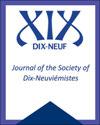Lèche-vitrines: Human Identity and the Mannequin in Au Bonheur des Dames
IF 0.2
4区 社会学
0 HUMANITIES, MULTIDISCIPLINARY
引用次数: 0
Abstract
ABSTRACT The department store mannequin is often read as representative of commodity or sexual fetishism and, consequently, of woman objectified. This article posits that in Émile Zola’s Au Bonheur des Dames (1883), the mannequin can highlight such objectification to the woman in the text. Through close readings of the text's mannequins this article seeks to analyse the combination of estrangement and excitement which characterizes the experience of living under modernity. It asks whether the headless Zolian mannequin empowers the shopper to recognize and thus reject objectification of the self, or if it is simply a disquieting reminder of one’s own powerlessness.橱窗陈列:《女士的幸福》中的人类身份和人体模型
百货商店的模特经常被解读为商品或性恋物癖的代表,因此,女性被物化了。本文认为,在Émile左拉的《女人们的欢宴》(1883)中,人体模特可以在文本中突出这种对女性的物化。本文试图通过对文本中人体模型的细读,分析现代性下生活体验中异化与兴奋的结合。它问的是,这个无头的左利亚人体模型是否赋予了购物者识别并因此拒绝自我物化的能力,或者它只是一个令人不安的提醒,提醒人们自己的无能为力。
本文章由计算机程序翻译,如有差异,请以英文原文为准。
求助全文
约1分钟内获得全文
求助全文

 求助内容:
求助内容: 应助结果提醒方式:
应助结果提醒方式:


